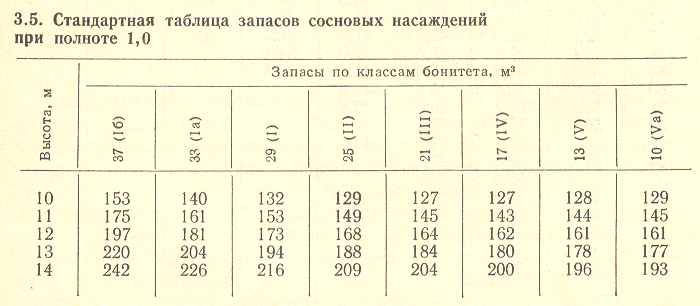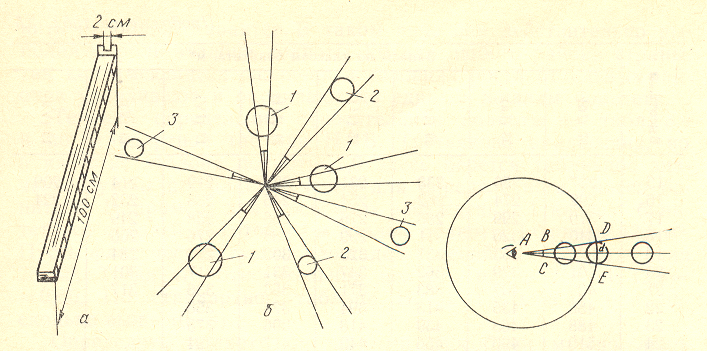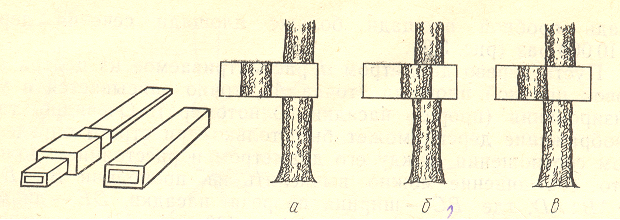Plant composition- a list of tree species that form the forest stand, indicating the share of each species in the total stock. A stand is called pure if it consists of 1 tree species or the admixture of other species does not exceed 10% of the total stock. Mixed - consists of several tree species. The composition of the forest stand is characterized by a formula that indicates the name of the species and a digital coefficient that determines the share of its participation in the total stock. The sum of all coefficients is equal to 10. In mixed forest stands, the share of participation of each species is determined by the ratio of their reserves or the sum of cross-sectional areas. If a tree species makes up only 2-5% of the growing stock, then it is written in the composition formula without a coefficient, but with a + sign. If the stock of a breed is less than 2% of the total stock, then its participation in the composition is marked with the word - single. To characterize the composition of plantings, it is necessary to correctly determine the dominant and main species. A breed is considered dominant if it accounts for the largest reserve; the breed that has the greatest economic importance is considered the main one. In ripening, mature and overmature plantings, the main species is considered predominant if its share of the stock is at least 50% of the total stock. For oak, cedar, beech this value is 40%. In young animals, the proportion of the main breed to the dominant one decreases by 10% - in the 2nd age class, and in the 1st - by 20%.
Type of forest and type of habitat conditions. Forest type - areas that are homogeneous in the composition of tree species and in other layers of vegetation, in fauna, in the complex of forest conditions, in restoration processes, that is, under the same economic conditions, requiring the same forestry measures. According to Sukachev's typology, the forest type is determined by the predominant tree species and the predominant representative of the living ground cover, which is an indicator of the growing conditions. To characterize the types of growing conditions, Pogrebnyak’s classification is used. TUMs are forest areas with homogeneous natural and climatic factors. For example, in Pogrebnyak’s classification, 2 factors are used: soil richness and moisture, completeness of planting - an indicator that characterizes the density of trees in a forest stand or the degree to which trees use the space they occupy in the forest stand. To determine the completeness of the forest stand, it is necessary to use the sum of cross-sectional areas and the degree of closure of tree canopy crowns. Completeness, which is determined through the sum of cross-sectional areas, is called taxation, and through the degree of crown closure - silvicultural. Taxation distinguishes between relative and absolute completeness. Absolute completeness is expressed in sq. m/ha - the sum of the cross-sectional areas per 1.3 m of all trees of the forest element and layer or as the total area of horizontal projections of the crowns forming the canopy of the forest stand. In production conditions, relative completeness is most often determined, which is determined in tenths of a unit. The completeness of a closed plantation per 1 hectare is taken as one, which is the maximum for a given species, age and growing conditions; such stands are normal, and the rest are modal. Relative completeness can be determined in 3 ways: 1) relative completeness is defined as the quotient of dividing the crown projection area by the total area occupied by them; 2) the ratio of the actual growing stock to the normal one: Potn = Mf/Mn; 3) in relation to the sum of cross-sectional areas of a taxed forest stand to the sum of cross-sectional areas of a normal forest stand: Potn=sum Gf/sumGn, Gn - according to tables of growth progress and a standard table of sums of cross-sectional areas and reserves of plantings at completeness 1. Gf can be determined by counting trees on a trial area using a measuring stick. And also in a selective measuring method by counting the number of trees on reloscopic circular areas using a Bitterlich full-meter or Anuchin prism. n=5 square roots of S, n is the number of reloscopic areas. In mixed stands, the value of completeness is found as the sum of the relative completeness of individual tree species. If any species predominates, the relative completeness can be determined by the predominant tree species. In complex plantations, the overall completeness is defined as the sum of the completeness of individual tree layers. In young trees, completeness is determined by the closeness of the crowns. Under production conditions, completeness is determined visually with an accuracy of ±0.1. In this case, growth progress tables or standard tables of sums of cross-sectional areas are used to train taxators. The marketability class is determined by the % of wood yield from the total stock or by the number of trunks (business) from the total number of trees in the forest stand. For coniferous plantations, 3 marketability classes are distinguished, for deciduous plantations - 4. To determine the marketability class, the following criteria are used: 1) in terms of the stock of industrial wood, coniferous plantations: 1 - 81% or more, 2 - 61-80%, 3 - up to 60%; deciduous: 1-71 or more%, 2 - 51-70%, 3 - 31-50%, 4 - less than 30%. 2) by % yield of business trunks: coniferous: 1 - 91 or more%, 2 - 71-90%, 3 - less than 70%; deciduous: 1 - 91% or more, 2 - 66-90%, 3 - 41-55%, 4 - less than 40%. The marketability class is determined for ripening, mature and overmature plantings for each forest element separately.
First way- as specialist shoemakers do: you need to measure the circumference of your foot with a flexible millimeter tape, let’s say, in a bun (at the widest places of the toe-bundle part), and according to special tables of GOST 3927 “Shoe lasts. General technical conditions" to determine completeness. This method is complicated and unacceptable for most buyers.
W = 0.25V-0.15C-A, (1)
where W is the required completeness number; B – girth in bundles, mm; WITH - foot length,
mm; A is a constant coefficient determined from the table. 3.2.
Table 3.2 – Group of shoes by gender and age
The length of the foot will be determined according to Fig. 3.2, girth in bundles - at the widest points of the toe part using a centimeter. Then simple calculations are carried out. Techniques for measuring feet are shown in Figure 3.2.
Measurement of the foot and lower leg. It is advisable to measure the feet of both feet, since often the right and left feet have different sizes and structures. The same sizes are found only in 20-30%. Begin measuring the feet by removing the outer and underarch contours. Place your foot (in a sock or stocking) on a measuring sheet of paper measuring 320x250 mm so that in a sitting position the lower leg is in a vertical position in relation to the supporting surface. The edges of the paper on all sides should protrude beyond the contours of the foot. To obtain the correct contour, the outline is made with a sharpened pencil split in the transverse direction so that the lead touches the foot and the pencil is perpendicular to the paper. Draw a circle around the foot from the middle of the back point of the heel of the foot, continuing along the inner contour of the foot to the end of the big toe. Then outline the outer side, starting from the heel and ending thumb. Thus, the outer contour of the foot is obtained, which makes it possible to determine the length of the foot, its width at the fascicles, heels and heels, the position of the toe arch, and, consequently, the appropriate shape of the toe in the shoe. After this, without changing the position of the leg, the underarch contour is removed, placing the pencil at a certain angle. The underarch contour determines the condition of the arches of the foot: the larger the recess in the arches with inside, the better the arches are expressed and the higher the instep of the foot.
Inside the contour of the foot, the following dimensional characteristics are indicated: heel width, tuft width, foot length, as well as foot girth in tufts, girth in a straight instep (in a section of 0.55 of the length of the foot), girth in an oblique instep (through the heel and the bend of the foot). Outside the contour of the foot, in a free space, the dimensions of the volume of the lower leg are written down in the form of a fraction: the height of the measurement is written in the numerator, and the value of the volume of the lower leg corresponding to this height is written in the denominator.
A. Zybin also proposed to use a nomogram - a stopometer (Fig. 3.3) to determine shoe sizes.
By constructing a family of straight lines according to various fullnesses using equation (1), we obtain a nomogram from which, knowing the girth of the foot and its size, we can obtain the desired value, i.e., one of the 12 parameters established by GOST 3927. Such a nomogram is practically a ready-made stopometer .
![]()
Figure 3.2 - Basic dimensional characteristics of the foot and lower leg
Using this equation, you can independently determine your fatness without a nomogram, for example, at home.
Circumference to foot length. The girth of a woman's foot is determined by the formula:
About st =0.59D+96 (2)
Where About st- foot circumference in the beam part corresponding to the section 0.68/072D;
D - the length of the foot between the most protruding points in the heel and toe.
The stop meter can be used to create your own size assortment of shoes (RAO) for a store, district, or region.
The use of a stopometer makes it possible to create a closed system that is currently missing:
buyer - store - wholesaler - manufacturer.
How should such a system function?
When a buyer comes to the store, he sees three departments with indicators for narrow, medium or wide feet. It's time to use the stopometer.
It should be noted that the difference between fullness is 4 mm, so deviations of ±1 fullness are possible depending on the habit of more spacious or tight-fitting shoes. After determining the necessary parameters, the client is sent to the desired department and easily selects a pair of shoes. And the obtained data on the completeness and size of a particular citizen can be entered into the computer memory for the subsequent formation of RAO. For statistical processing, about 600 measurements will be quite enough, as a result - for the first time in the world, each store can have its own RAO developed, and shoes will be sold evenly, without overstocking.
Thus, by systematizing information obtained from different sources, it is possible to compile RAO for individual stores, districts and regions.
When sales volume expands, and this will inevitably happen, as people will understand what it really means comfortable shoes, the specialization of individual workshops, and possibly enterprises, is real. And then we will come to the Western organization of industrial work: shoe companies, for market reasons, produce shoes of only certain sizes, and buyers, without even knowing the parameters of their feet, but knowing which lasts from which companies fit them, buy shoes only from these companies.
Procedure and methodology for performing the work:
1. Study shoe size numbering systems.
2. Measure the length of the foot from the most protruding point of the heel to the most protruding toe.
3. Determine shoe size in accordance with domestic and foreign systems.
4. Determine the fullness of the shoes using the proposed method.
5. Determine completeness for various systems.
6. Draw a conclusion about the work.
Questions for self-control
1.Name the existing shoe numbering systems.
2. How does the English shoe numbering system differ from the American one?
3. How to determine your shoe size?
4. Name the methods for determining the fullness of shoes.
5. How many half-length shoes exist in Russia in accordance with regulatory documents?
Figure 3.3 - Nomogram-stopometer.
Table 3.3 - Foot measurement results
Appendix A - Measurement Sheet
In any forest stand, the nature of the arrangement of trees in area, as well as their density, are different. It depends on the tree species (light-loving, shade-tolerant), growth conditions (bonitet class), the size of the trees and the condition of the tree stand itself. Trees of light-loving species, in comparison with shade-tolerant ones, ceteris paribus, form less dense stands. For the same size of trees, plantings under better growth conditions have a larger number of trunks per unit area than those growing under worse conditions. Despite the fact that with increasing age and size of trees, their number per unit area decreases, the sum of their cross-sectional areas and the stock of the planting increase. Tree stands that have undergone various cuttings (selective, sanitary, maintenance) are, as a rule, more thinned out than those that form naturally.
To estimate the density of trees, the concept of completeness forest stand, which is understood as an indicator characterizing the degree to which trees in the forest use the space they occupy.
Completeness is one of the most important taxation indicators, which allows one to determine the stock of a planting, characterize its condition and plan economic activities. To determine the completeness of a forest stand, you can use data on the sum of its cross-sectional areas, stock, number of trees per 1 hectare and degree of canopy closure. Completeness, established by the sum of cross-sectional areas, is called taxation and serves to determine stock and growth. Completeness determined by the degree of crown closure - forestry and serves to schedule business activities.
In the same planting, taxation and silvicultural completeness may differ. The ratio between them is not constant and varies depending on the species, age, state of the plantings and growing conditions.
A distinction is made between absolute and relative completeness. Absolute the completeness of the stand is expressed in square meters per 1-ra as the total sum of the cross-sectional areas at breast height of all trees in a forest element or layer (for example, 32 m 2) or as the total area of horizontal projections of the crowns forming the canopy of the forest stand (for example, 6000 m 2).
In production conditions it is more often determined relative completeness, expressed in tenths of a unit. One unit is taken as the completeness of a closed stand per 1 hectare, which is maximum for a given species, age (height) and growing conditions. Such plantings are called normal. According to a given condition, a planting is considered normal in which all the natural capabilities of the area it occupies are used to the maximum extent, that is, one in which there are no extra or missing trees. If some more can be added to the forest stand without damaging the surrounding trees, then its completeness will be less than 1.0. Thus, forest stands with a completeness of 0.5 include those in which You can add as many more of the same trees to the existing quantity.
Relative completeness in terms of canopy closeness is determined as the quotient of dividing the area of the projection of the entire canopy of a tree stand (absolute closeness) by the total area occupied by it:
P = 6000 m 2 /10000 m 2 = 0.6
Normal plantings, i.e., whose completeness is 1.0, also have maximum wood reserves. This circumstance can be used to determine the completeness of other, more sparse forest stands, by calculating the ratio between their reserves and the reserves of normal stands.
For example, a taxed pine plantation of quality class II at the age of 70 years has a reserve of the growing part of 260 m 3 /ha. Using special tables compiled to characterize the progress of growth of normal plantings (see reference books), we find that the stock of the same planting at a density of 1.0 is equal to 383 m 3. Then the completeness of the taxed forest stand will be equal to
P = Md/Mn = 260/383 = 0.68 (rounded to 0.7)
Determining the growing stock is a rather lengthy and complex operation. Therefore, relative completeness is often determined in a simpler, but no less accurate way, based on the ratio between the sum of cross-sectional areas of taxed ΣGd and normal ΣGn forest stands for the same species, age and conditions according to the formula P = ΣGd / ΣGн. This is explained by the fact that there is a close relationship between the stock and the sum of cross-sectional areas in a forest stand: the relative completeness of average planting density, determined by the stock and the sum of cross-sectional areas, is practically the same.
Let us assume that in the same pine forest, by continuous counting with a measuring fork or by laying out circular test areas with a Bitterlich full-meter or N.P. Anuchin’s prism, the sum of cross-sectional areas (absolute completeness) was established equal to 25 m 2. In a normal planting, according to general tables of growth progress (compiled by A.V. Tyurin), the sum of cross-sectional areas is equal to 37.2 m 2. Then the relative completeness will be:
П= ΣGд / ΣGн =25/37.2 = 0.67 (rounded to 0.7).
Information about completeness allows plantings to be classified according to their actual productivity.
For example, in a tree stand with a density of 0.5, with other identical taxation indicators, the stock is 2 times less than with a density of 1.0, etc. Consequently, the relative completeness of the planting, just like the quality class, serves as a classification feature and should be established according to uniform rules and regulations.
The correct definition of relative completeness largely depends on what is taken as the standard of completeness, i.e., 1.0. In different growth progress tables compiled for individual geographical areas, the sums of cross-sectional areas even for the same breed, age and quality class are not the same. Using them as a standard of completeness leads to the fact that plantings taxed in different areas, having the same sums of cross-sectional areas and even reserves, will have different, incomparable relative completeness. In order to eliminate this drawback, as well as simplify the calculation technique, in 1937 a group of employees of the TsNIILKh under the leadership of N.V. Tretyakov proposed standard table of sums of sectional areas and reserves plantings at a density of 1.0 (see forest taxation directories). Its construction is based on Eichhorn’s theory that within a rock, the sum of cross-sectional areas and reserves of normal plantings can be determined by their height, regardless of the geographical area, growth conditions and other taxation indicators. Therefore, the initial data for the table are only the tree species and the average height of the tree stand.
The technique for determining relative completeness using a standard table is very simple and boils down to the following. Let the average height of the pine plantation be 24 m, and the sum of the cross-sectional areas be 28 m2. According to the standard table, the sum of the cross-sectional areas of the same planting with a density of 1.0 should be 36 m 2. Then the relative completeness of the taxed planting will be:
П= ΣGд / ΣGst = 28/36 = 0.78 ≈ 0.8.
N.V. Tretyakov’s standard table, compiled based on data from a relatively small number of growth progress tables, has significant shortcomings, so in recent years there have been repeated attempts to improve it. According to our research (based on materials from 250 tables of growth progress), it turned out that species numbers (species heights), sums of cross-sectional areas, as well as reserves of normal plantings of the same species at the same average height depend not on the geographical area, but on the conditions of their habitat, indirectly reflected by quality classes. When growth conditions worsen (lower quality class) at the same average height in normal plantings, the sum of cross-sectional areas and stock decrease. This pattern is general character and manifests itself in any geographical area. The obtained conclusion was the basis for the standard tables we developed for the sums of cross-sectional areas and reserves of a new type, the initial data in which are the species, the average height of the tree stand and the quality class (Table 4). Similar tables developed for the main forest-forming species of the country are placed in forest taxation directories. The advantage of these tables is that, in addition to height, they also take into account growth conditions, which allows them to maintain their general character. In this form, they really serve as a standard of completeness of 1.0 for any region of the country, since existing differences in the growth conditions of individual regions are captured and assessed according to uniform quality scales.
Technique for determining relative completeness according to table. 4 and according to the standard table of N.V. Tretyakov is similar, but here the tabulated value of the sum of cross-sectional areas for a certain quality class is taken as a standard of completeness of 1.0. For example, for a pine planting of quality class I with an average height of 24 m, the standard of completeness 1.0 is equal to 42.6 m 2. Let the actual sum of the cross-sectional areas of this planting be 28 m2. Then its relative completeness is equal to P = 28/42.6 = 0.66. According to the standard table of N.V. Tretyakov, it is slightly higher (0.78).
|
|
It is possible to determine the completeness using the methods described only if there is data on the sum of cross-sectional areas or reserves obtained from census data. In production practice, relative completeness is determined visually with an accuracy of ± 0.1, while data from standard tables or local tables of growth progress are used to train the taxator’s eye. For this purpose, in the most common forest stands of the taxed object (forestry, forestry), before starting work, several dozen trial plots are laid out, on which the sum of cross-sectional areas is established by counting. By comparing them with the data of standard tables, the relative completeness is determined, which serves as a kind of guide for visual determination of completeness in other tree stands. As an additional guideline, data on crown density, tree density and tree diameters are used.
Determining the sum of cross-sectional areas of a forest stand (its absolute completeness) by counting trees with a measuring fork is a labor-intensive task. It can be determined more quickly and accurately enough by a selective measuring method - by laying out circular, so-called relascopic platforms using special devices (angular templates), called full-meters in the domestic literature.
The full-length meter was first proposed in 1948 by the Austrian forester W. Bitterlich. It is a wooden or metal strip (ruler) one meter long, to one end of which a nozzle with a cutout 2 cm wide is attached perpendicular to the length (Fig. 2). The full length may be of other sizes, but in all cases the ratio of the width of the nozzle cutout to the length of the device should be equal to 1: 50, i.e. the length of the device is 50 times greater than the width of the nozzle.
The technique for determining the sum of cross-sectional areas per 1 hectare comes down to the following. In a taxed forest stand, they choose a typical place and stand in its center. Having placed the end of the device free from the nozzle to the eye and taking any noticeable tree as the origin of reference, they turn 360" (a full turn), sighting through the nozzle one by one at the diameters (at chest height) of the surrounding trees.
|
R |
Rice. 2. Bitterlich completeness:
A - device diagram; b - principle of operation: 1 - trees to be counted for 1 m 2, 2 - the same for 0.5 m 2, 3 - not counted
Rice. 3. Scheme of theoretical justification for the operation of the full-volume meter
The cross-sectional area of each tree, the diameter of which overlaps the slot of the nozzle (sight angle), is taken as 1 m2, and the diameter that exactly closes the slot is 0.5 m2. Other trees are not subject to counting. The number of counted trees is equal to the sum of the cross-sectional areas per 1 hectare in the taxed area of the forest stand, expressed in square meters.
For example, when laying out a circular test plot (a complete revolution around itself), the number of trees covering the slot of the full-length gauge turned out to be 20, exactly covering it was 5. Then the sum of the cross-sectional areas of all trees per 1 hectare is equal to 20 = 20 + 5 * 0.5 = 22.5 m 2.
The invention of the full-meter was the largest achievement of forest taxation in recent years. It has greatly simplified and facilitated the determination of the completeness of forest stands and the accounting of their wood reserves. Nowadays such
The method has become widespread all over the world, including in our country, during forest inventory work, during the taxation of forest and logging funds, etc.
|
Rice. 4. |
Rice. 4. Taxation sight (prism)
Rice. 5. Principle of working with a prism
To make the full-meter more compact, it is sometimes made smaller (for example, 50 cm long and with a 1 cm wide nozzle slot) or devices based on the optical principle are used instead: Bittelich's relascope or taxation sight (prism) by N. P. Anuchin. The operating principle of the taxation sight is based on the property of refraction (shift) of the image of a tree when viewed through a wedge-shaped prism. The angle of refraction of the prism is selected equal to the angle of sight through the slot of the Bitterlich full-meter.
The tax sight (Fig. 4) is a glass prism enclosed in a case. In the working position, the prism is fixed to the case so that it acts as a handle.
The unfolded device is raised to eye level and placed in a position perpendicular to the line of sight on the tree trunk at chest height. The prism can be held at any distance convenient for the eye. Sighting at the tree trunk is carried out simultaneously through the prism and on top of it. In this case, the part of the trunk viewed through the prism will move to the side. In case of partial shift (Fig. 3.5, b), when the shifted part does not extend beyond the thickness of the tree, its cross-section is taken as 1 m", and if it does (Fig. 3.5, A) and seems to hang in the air, then such a tree is not taken into account. With a shift exactly equal to the thickness of the tree (Fig. 3.5, c), it is taken as 0.5 m." Otherwise, the technique for laying out circular test areas with a prism is the same as when using a Bitterlich full-meter. In terms of the accuracy of determining ΣG, both devices, provided they Proper manufacture and application give the same results.
A relatively small circular sample area covers only a small part of the taxed forest stand, which may be heterogeneous in structure. Therefore, the data obtained on one sample plot cannot be extended to the entire area. In order to obtain a general characteristic of the taxed forest area (alpartment), it is necessary to lay out several sites located evenly throughout the entire area.
Research has proven that to obtain ΣG per 1 hectare with an accuracy of +10% with a probability of 0.95 (i.e. in 95 cases out of 100), it is necessary to lay 4...6 circular sites. With a larger forest area being taxed, the number of sites increases. It can be approximately calculated using the formula: n=5*root(S)
where: S is the area of the allotment.
In mixed stands, the exact value of completeness is found as the sum of the completeness of individual species. If there is a clear predominance of one species in the composition (with its share in the composition of more than 8 units), the relative completeness of the entire forest stand can be established in the same way as in a pure forest stand. In complex plantings, the total completeness is established as the sum of the completeness of the individual tiers. In plantings with an average height of less than 3 m, the density is determined by the density of the crowns. In non-closed young stands - according to the number of trunks per 1 hectare. If the number of trunks corresponds to the lower limit of satisfactory renewal (according to accepted standards), the completeness is assumed to be conditionally equal to 0.4.


 is. 2 Fig. 3
is. 2 Fig. 3 Rice. 5.
Rice. 5.

